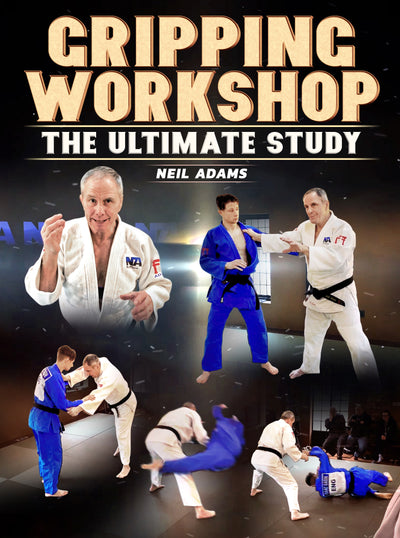One Handed Tai Otoshi With Jimmy Pedro
Tai Otoshi translates as Body Drop, “Tai” meaning Body and “Otoshi” meaning Drop, and is classified as a Te Waza (hand technique) as the hands play the central role in executing the throw. As Tai Otoshi is one of the original 40 throws developed by Jigaro Kano, and belonging to the second group (Dai Nikkyo) of the Kodokan curriculum, it is a staple forward throw in the Judo arsenal and a high percentage technique.
We will first look at an orthodox Tai Otoshi to gives us the foundation for understanding a one handed Tai Otoshi.
In classical Judo Tai Otoshi is practised by first taking an orthodox sleeve and collar grip, which is used for kuzushi (breaking balance) by pulling our opponent forward to their own right front corner and onto the balls of their feet. From here tori (the one who executes the technique) steps their right foot past uke’s (the one receives the technique) right foot and then uses the action of both hands to throw over that right foot. The right hand gripping the collar is used to push and the sleeve hand is used to pull. Successful execution of Tai Otoshi can rapidly switch the momentum of a match with either an ippon or place us in a strongly dominant position for groundwork.
Jimmy recommends that when we first learn tachi waza (standing technique) we have our uke stand in a neutral stance with their feet along a single horizontal plane of balance. This gives us a simple, straightforward base to learn the technique. As Jimmy is a left hand oriented Judoka his grip is the opposite of the traditional right collar grip and so Jimmy grips his opponents collar with his left hand and has his left foot forward. The grip that Jimmy takes is a dominant inside grip, meaning that his arm is on the inside of his opponents arm. Jimmy’s right hand grips his opponents’ sleeve, making sure there is no slack in the gi so that positive control is gained of his opponents wrist and arm. A one handed Tai Otoshi is best used in a left vs left or right vs right stance, so here Jimmy’s uke is also taking a left handed stance.
Ready to join the Judo Academy With Jimmy Pedro and Travis Stevens? Click Learn More!
From this grip kuzushi is now gained by pulling both hands upwards and towards ourselves. Jimmy’s right arm, the sleeve grip, extends and pulls upwards as if he is looking at his wristwatch. This movement extends Jimmy’s uke along a diagonal line and forwards onto the balls of their feet, leaning to the side of the sleeve grip hand. The left hand grip Jimmy has on his opponents collar now pulls upwards and towards Jimmy, and he makes sure that his wrist comes up by uke’s ear while Jimmy pulls his arm into his own body. When Jimmy pulls his collar grip upwards by uke’s ear he takes the slack from the gi, moves his opponent towards him and also creates space for his forearm so that his elbow and forearm are active against his opponent and he has a strong frame for the throw.
Now having broken his opponents balance Jimmy steps his left foot forward so that his foot and his opponents two feet make a triangle. Jimmy’s back foot then comes around to the outside of his opponents foot and his lead foot at the top of the triangle now steps across to the outside of uke’s weight bearing foot. Jimmy’s leg here is slightly bent and engaged with his opponents shin and there is space between Jimmy and uke. From here we pull through the throw to complete an orthodox Tai Otoshi.
For the one handed Tai Otoshi variation we see Jimmy adapting to an opponent that has sleeve control at the elbow of his lapel gripping arm. If Jimmy tries to keep the grip at the lapel and execute Tai Otoshi this becomes very difficult because the opponents sleeve grip shuts down the movement of the arm by acting as a frame against Jimmy’s elbow. To overcome this Jimmy takes his grip off his opponents lapel so that he regains control of his own arm and is able to move it across his own body. Having regained movement in this side of his body Jimmy can once again have full rotation to throw with tai Otoshi.
The steps for one handed Tai Otoshi here are that the lapel grip releases, the kuzushi of our own sleeve grip remains the same by using the ‘look at our wristwatch’ technique, and our freed lapel grip comes across our opponents body to the arm that we have a sleeve grip on. One detail to note is that when Jimmy releases the lapel grip he does try to free the grip his opponent has on his sleeve but if this is not successful it doesn’t negatively impact the one handed Tai Otoshi. This freed hand chops into our opponents arm anywhere between their shoulder and elbow while our sleeve grip continues to create kuzushi for us. From this position of chopping into the opponents arm to create kuzushi we complete our orthodox footwork and pull in a circular motion to complete the throw.
Jimmy learned this one handed variation of tai otoshi from Mike Swain and then implemented it during the World Finals against his Russian opponent, narrowly missing ippon.

For more game changing details for your stand up work see Olympian and Olympic coach Jimmy Pedro’s full courses at Judo Fanatics here!



